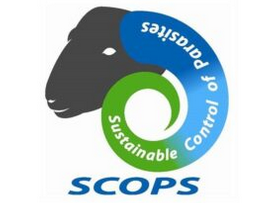Practical advice issued for users of the SCOPS Nematodirus Forecast

Wide fluctuations in temperature, weather patterns and topography means the nematodirus threat continues to be hugely variable for sheep flocks up and down the UK – which is why the traffic light warning system built into the Nematodirus Forecast provided by the Sustainable Control of Parasites in Sheep (SCOPS) group is so valuable to sheep farmers.
Speaking on behalf of SCOPS, independent sheep consultant Lesley Stubbings says:
“The map currently shows a wide range of colours, from grey (negligible risk) in some upland areas through yellow and orange (low and moderate risk) to red and black (high and very high risk). If you’ve been following the forecast since it went live in February you’ll have seen the red and black dots start in the far south west of England and steadily sweep northwards, which is what we would expect.”
But what happens once a dot has turned black to indicate the highest risk? The answer is that it goes back to red and through the colours until, eventually, it returns all the way to grey. It won’t return to black again. This means you need to check the map regularly, so you know if a red dot is one when the risk to heading up towards black or coming down again having already been at very high risk. If you are not sure, the SCOPS service provides this information in the “Historic Data” area of the forecast.
When you visit the forecast at www.scops.org.uk/nematodirus, the “Historic Data” is an option in the menu. There is also an archive of what has happened in previous years.
The image below shows a snapshot of historic data with Mount Batten weather station (near Plymouth) showing moderate risk (orange) having already passed the high and very high risk periods, whereas Milford Haven (South Wales) and Boscombe Down (Wiltshire) are yet to reach their high risk periods. Also note that each weather station states it’s height above sea level (asl), so users can compare this to the area where their flock is grazing.
Ms Stubbings continues:
“Once the risk starts to fall back it means that the chance of a large, sudden hatch of nematodirus eggs is also reducing, because there has been ample warmth to allow the eggs from last year to hatch. If you have been following your local weather station carefully, you will know the risk has receded and levels are on the way down. If you are new to the forecast or haven’t looked for a while, you can go to the historic data files and check to see if this is the peak or if the risk is on the way back down.”
It is important to understand that it is a sudden, mass hatch of nematodirus eggs at the point in time when lambs first start taking in significant amounts of grass that is the greatest threat. Low level, sustained exposure to the larvae will result in lambs developing immunity (hence adult sheep are not affected) so the priority is protecting naïve lambs when the risk it greatest.
Looking at the pattern this year, Ms Stubbings says: “Many lowland flocks in the southern half of the country have now passed the high risk period for a sudden, mass hatch. In contrast, the hill and upland areas have yet to reach high/very high risk and need to be on their guard if there is a sudden increase in temperatures. Monitor the colour of the dot most appropriate to you on the map and, if in doubt, check the historic data just to make sure you haven’t missed the peak.”
The SCOPS Nematodirus Forecast is a free resource for the UK sheep sector, thanks to the generous sponsorship of Bimeda and Techion (FECPAKG2).

